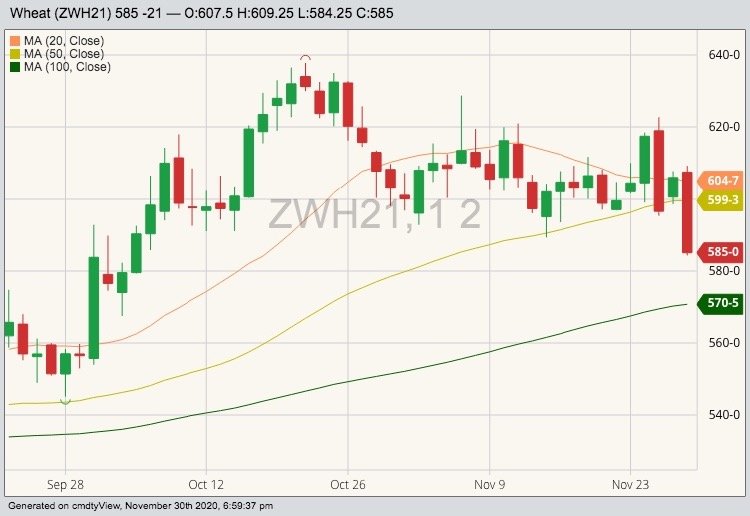Chicago | Reuters — U.S. wheat futures fell more than three per cent on Monday on prospects that Russia, the world’s top supplier of the food grain, may raise its export quota, analysts said, along with long liquidation at the end of the month.
Soybean and corn futures dipped as rains fell on parts of crop areas in Brazil and Argentina, easing drought worries.
Chicago Board of Trade March wheat settled down 21 cents at $5.85 per bushel (all figures US$). CBOT January soybeans ended down 23-1/4 cents at $11.68-1/2 a bushel and March corn fell 7-3/4 cents to settle at $4.26 a bushel.
Read Also

U.S. grains: Soybeans bounce as Chinese demand assessed, wheat drops
Chicago soybean prices firmed on Friday in a bargain-buying bounce after a sharp fall on Thursday, as traders assessed prospects for more U.S. sales to China after the trade war truce between the countries.
Wheat fell after Russia’s agriculture ministry said the country may increase the size of its grain export quota planned for Feb. 15 to June 30 to 17.5 million tonnes, from 15 million tonnes.
“It does make a little bit more (wheat) available to the world market,” said Jack Scoville, vice president for Price Futures Group in Chicago.
Also, the Australian Bureau of Agricultural and Resource Economics and Sciences (ABARES) raised its estimate of the country’s 2020-21 wheat production to 31.17 million tonnes, up from 28.91 million previously.
After the CBOT close, Egypt’s main state wheat buyer set an international wheat purchase tender, its second within a week. Results were expected on Tuesday.
CBOT soybean and corn futures retreated on Monday after firming in early moves, pressured by weekend rains in dry areas of Argentina and southern Brazil.
“The worry about dry weather in South America, especially Brazil and Argentina, has been supporting soybeans in the past week and now we are seeing rain in parts of these countries,” said Matt Ammermann, StoneX commodity risk manager.
CBOT most-active corn futures touched their highest level since July 2019 on Monday before turning lower. The benchmark soybean contract retreated after failing for a fourth straight session to match its Nov. 23 high of $12 a bushel.
“When you are in a weather market and all of a sudden the weather changes, you are going to get a reaction,” Scoville said. “Plus, there is some liquidation just because it is the end of the month, and some of the funds are booking some profits.”
For the month of November, CBOT March corn rose 5.6 per cent and January soybeans rose 10.6 per cent, while March wheat fell 2.5 per cent.
— Reporting for Reuters by Julie Ingwersen in Chicago; additional reporting by Michael Hogan in Hamburg and Naveen Thukral in Singapore.












